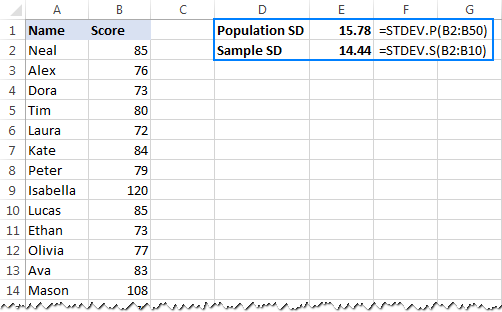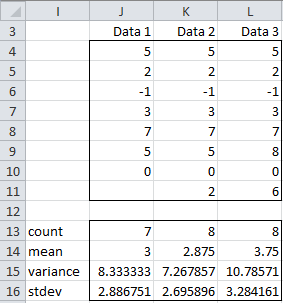

- Excel average and standard deviation in same cell how to#
- Excel average and standard deviation in same cell manual#
The screen below shows how to manually calculate standard deviation in Excel.Ĭolumn D calculates Deviation, which the value minus mean. With Excel, you just have to call the STDEV function and you will return the result in.
Excel average and standard deviation in same cell manual#
Manual calculations for standard deviation To calculate the standard deviation, you dont need to know the formula. In these cases, Bessel’s correction may not be useful. On the other hand, a large enough sample size will approach the statistics produced for a population. Remember that a small sample is not likely to be a good approximation of a population in most cases. If you have sample data, and only want standard deviation for the sample, without extrapolating for the entire population, use the STDEV.P function.If you have an appropriately large sample and you want to approximate standard deviation for the entire population, use the STDEV.S function.If you have data for an entire population, use STDEV.P.When should you use STDEV.S, which includes Bessel’s correction? It depends. The STDEV.S function uses Bessel's correction.In the context of Excel and standard deviation, the key thing to know is: When working with a sample population, Bessel's correction can provide a better estimation of the standard deviation. It appears in formulas as n-1, where n is the count. However, when you calculate statistics for a sample, results are estimates and therefore not as accurate.īessel's correction is an adjustment made to correct for bias that occurs when working with sample data. When you calculate statistics for an entire population (mean, variance, etc.) results are accurate because all data is available. in the following table, and paste it in cell A1 of a new Excel worksheet. IF the data is just a sample, and you want to extrapolate to the entire population, you can use the STDEV.S function to correct for sample bias as explained below. The standard deviation is a measure of how widely values are dispersed from. If the data represents the entire population, you can use the STDEV.P function. When you let go, Excel fills in all the cells with a number series. You have now selected both K2 and K3 like this: Grab the little square at the bottom right of the cells and drag it down to K18. Filling Cells with a Number Series Select K2, drag to K3, and let go.

To calculate standard deviation in Excel, you can use one of two primary functions, depending on the data set. When you let go, Excel fills in all the cells with the same number. If needed, you can change the chart axis and title.

Standard deviation is a measure of how much variance there is in a set of numbers compared to the average (mean) of the numbers. Create a Standard Deviation Excel graph using the below steps: Select the data and go to the INSERT tab then, under charts select scattered chart then, select Smoother Scatter Chart.


 0 kommentar(er)
0 kommentar(er)
